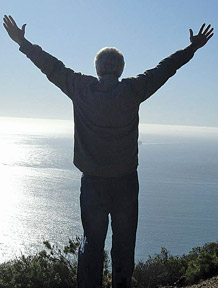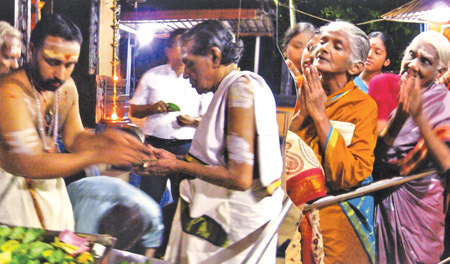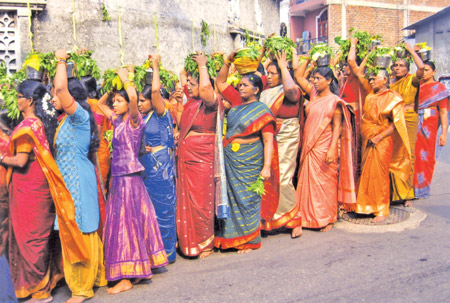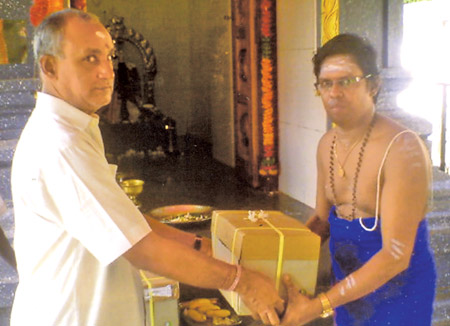HINDUISM
Maha Sivarathri
Significance of Nanthy flag for peace and prosperity:
Chelvatamby Maniccavasagar
Maha Sivarathri which falls on March 2nd 2011 will be observed in
every temple particularly in Shivan temples and also in Hindu homes. The
whole day and night will be profitably spent in temples. The night which
is devoted to Lord Shiva as the term Sivarathri indicates is more
important than the observances of rituals during the day.
 |
 |
|
Maha
Shivarathri brings you a blissful experience of Shivashakti |
At a temple the night is divided into four quarters from sunset to
sunrise. Ceremonies like Abishehams, Pooja and Archanai are performed in
each quarter and at the same time in a separate place, there will be
continuous performances of devotional music and religious discourses to
enable to devotees to pass the time in prayers and meditation without
sleeping throughout the night.
The night is emphasized to signify the darkness of the world of
senses in which we find ourselves, the endeavour is to pass from
darkness to light, from night to the day of deliverance.
Early in the morning after Maha Sivarathri night, the slender streak
of the moon in its last phase escapes from the darkness which threatens
to swallow it up by union with the resplendent rising sun.
This is symbolic of the achievement of Moksha, Heavenly Bliss,
illumination, liberation from Samsara or Salvation and it is in essence
the realization of the object of one’s life.
In fact, Lord Shiva in his aspect of Nataraja or the cosmic dances on
Maha Sivarathri day is represented as working out the infinite modes of
rhythm in the process of universal creation, preservation and
destruction. The small drum (Udukkai) is one hand symbolics creations,
the Abayakara or the hand dispelling fear and assuring protection
symbolise preservation. Fire in another hand depicts the aspect of
destructions. These three fold nature of God Absolute is brought out by
the dance of Lord Shiva on Mahasivarathri day.
Furthermore in every Shivan Temple there is a Nanthi (bull) which is
the Vahana or vehicle of Lordshiva. It is always found facing
shivalingam in the places of worship. In fact, Nanthy represents Dharma
and the Hindus were told to govern their lives by the norms of Dharma
which comprehends all the excellence which make for an ideal humanity.
 Dharma is an internal discipline by which is given social order is
protected. It is by Dharma that civilization is maintained. Therefore,
Dharma may be defined as social norm or moral law. Since Nanthy or the
sacred bull is said to be the vehicle of Lord Shiva, it also means that
Dharma is the vehicle or Lord Shiva. Dharma is an internal discipline by which is given social order is
protected. It is by Dharma that civilization is maintained. Therefore,
Dharma may be defined as social norm or moral law. Since Nanthy or the
sacred bull is said to be the vehicle of Lord Shiva, it also means that
Dharma is the vehicle or Lord Shiva.
Indeed, there is a flag for every nations, every religion and every
political party without any exception. They hoist these flags in all
important occasions and the whole world comes to know of their
respective celebrations on accounts of their flags. But, there was no
such flag common to Hindus to be hoisted during festivals anywhere in
the world. Realizing this Divine Service the world Saiva Councils’ (Sri
Lanka) vice president, vice-president of All Ceylon Hindu Congress, Vice
President of Vivekananda Society and Trustee of the Colombo Saiva
Munneta Sangam “Vidaikadi” Sinnadurai Dhanabalan (JP), Secretary of the
world Saiva Council (Sri Lanka) and President of the Tamil Sangam Dr
Muttiah Kathirgamanathan, K Thayaparan, President of World Saiva Council
(Sri Lanka Branch) and several other eminent personalities like Raja
Manohari Pulendran, Subramaniam Chettiar,Trustee of the New Kathiresan
Temple, Bambalapitiya have taken all possible steps to hoist Nanthy
Flags at New Kathiresan Temple at Maha Sivarathri Day and distribute
these flags to all the devotees and well-wishers.
Furthermore, these flags will be hoisted at various Hindu temples in
Sri Lanka particularly at Thiruketheeswaram temples, Munneswaram temple,
Koneswaram temple, Naguleswaram temple and Kochchikadai Sivan temple. On
this Maha Sivarathri Day Nanthi flags will be hoisted in foreign
countries in religious organizations and temples particularly in London,
South Africa, Australia, Canada, France.
Furthermore, the World Saiva Council was established on February 29,
1992 at a public meeting of International Delegates held at the Saiva
Siddhantha Peru Mandram, Mylapore, Madras with the aim to preserve,
foster and promote saivaism, Saiva Siddhantam and the welfare and
progress of Saiva Hindus throughout the world.
In fact Maha Sivarathri was chosen as Saiva flag day, not only
because it was an important festival for the saivitees, but also because
it was a rare occasion when a large numbers of devotees would congregate
in temples. Further, the main purpose of conducting the sale of flags
was to raise funds for development and welfare profits in Sri Lanka.
Indeed, the flag hoisting ceremony in temples particularly on Maha
Sivarathri Day indicates that the descendant of Kundalani Sakthy at
Moolatharam of our spinal chord should rise to the head. The flag
lowering ceremony indicates that the supreme consciousness decends down
from the head to the body (Creation) and reach the end of the spinal
chord.
In fact, the hoisting of Nanthi flag at the top of the Rajagopurams
of the temples and in other religious organizations will undoubtedly
explain the principles and philosophies of Saivaism to achieve the goal
of life.
Four aims of life
K S Sivakumaran
Our ancients have identified four aims of life for a Hindu. All human
beings have an aim in life. However most of us are engrossed with the
requirements of the body and our aims centre round it. The Hindu
conceptions of an ideal life are called Purushathamams. It consists of
Artha, Kaama and Dharma. Artha causes all our attempts to acquire
worldly possessions. Kaama is enjoying them and Dharma is our duties to
the society.
|

Moksha is the predominant aim |
The Hindu Sastras like the Arthasastra, Kaamasastra and the
Dharmasastra give details to be followed for the realization of these
pursuits. We must remember that the concept of Moksha is the predominant
aim in Hindu thought. Moksha is really liberation from ignorance. It is
a fact in Hinduism that all research, teaching and writing were
concerned with the supreme spiritual theme of liberation from ignorance
and from the pursuits of the worldly life.
One of the ancient poets in Thamil, a woman, Avvai summarizes the
four aims of life in one single verse. Roughly her verse means this:
Dharma ischarity and duty.
Artha is acquisition of worldly possessions by righteousmeans, Kaama
is reciprocated love and Moksha is freedom from all thesethree. The
climax is Moksha. It is realized when one gives up one’sdesire for
wealth, pomp and power.
Within a short span of human life the period allocated for Moksha is
practically none.
From the cradle to the funeral pyre our time is fully occupied in
seeking the means of acquiring wealth and enjoying them. What little
time could be spared is swallowed up by social obligations and duties in
the name of religion and charity. What does Moksha mean? It is not
visible like property, gold or a desirable woman. Nor is it any kind of
feeling.
It is really freedom from – Illusion. The first illusion is
identification of the self with the body. All religions declare that the
Self is not the body. However nobody seems to take them seriously. Our
one pursuit in life is to keep it nice and comfortable.
The second illusion is that we will not die in spite of seeing death
all around us every moment. The third is the identification of the self
with the mind. The mind is compared to the antics of a monkey.
The forth illusion is that we have an abidingpersonality. Moksha is
also known as Paramartha. It means the permanentobject or the ultimate
reality. We must also consider this: If freedomfrom everything that we
consider real is Moksha, then the religions, theirrituals, ceremonies
are not of much use. So what’s required isdiscriminating and realizing
truth from untruth. The moment one realizesthat there is One behind the
phenomenal world and that forms and names areillusory, the aims for
which we spend all our lives would be meaningless.
That does not mean that we should give up this world and live on the
topof a hill. We can live in the midst of this world and ye know that
this isa passing show. It’s like watching a film. At the back of our
mind weknow that the film is not real but a created illusion.
Similarly it is the attitude and not the change of place or mode of
life that matters. If at all we should identify ourselves with something
like body, mind or ego, let us at least know that we are not any of
these. As Avvai says the only correct vision is to see the One behind
everything. That would give eternal peace.
Universal wisdom
Swami Vivekananda:
Three religions now stand in the world which have come down to us
from time prehistoric - Hinduism, Zoroastrianism, and Judaism.
 They have all received tremendous shocks, and all of them prove by
their survival, their internal strength. But while Judaism failed to
absorb Christianity and was driven out of its place of birth by its
all-conquering daughter, and a handful of Parsees is all that remains to
tell the tale of their grand religion, sect after sect arose in India
and seemed to shake the religion of the Vedas to its very foundations,
but like the waters of the sea-shore in a tremendous earthquake it
receded only for a while, only to return in an all-absorbing Hood, a
thousand times more vigorous, and when the tumult of the rush was over,
these sects were all sucked in, absorbed and assimilated into the
immense body of the mother faith. They have all received tremendous shocks, and all of them prove by
their survival, their internal strength. But while Judaism failed to
absorb Christianity and was driven out of its place of birth by its
all-conquering daughter, and a handful of Parsees is all that remains to
tell the tale of their grand religion, sect after sect arose in India
and seemed to shake the religion of the Vedas to its very foundations,
but like the waters of the sea-shore in a tremendous earthquake it
receded only for a while, only to return in an all-absorbing Hood, a
thousand times more vigorous, and when the tumult of the rush was over,
these sects were all sucked in, absorbed and assimilated into the
immense body of the mother faith.
From the high spiritual flights of the Vedanta philosophy, of which
the latest discoveries of science seem like echoes, to the low ideas of
idolatry with its multifarious mythology, the agnosticism of the
Buddhists and the atheism of the Jains, each and all have a place in the
Hindu’s religion.
Where then, the question arises, where is the common centre to which
all these widely diverging radii converge? Where is the common basis
upon which all these seemingly hopeless contradictions rest? And this is
the question I shall at tempt to answer.
The Hindus have received their religion through revelation, the
Vedas. They hold that the Vedas are without beginning and without end.
It may sound ludicrous to this audience, how a book can be without
beginning or end. But by the Vedas no books are meant. They mean the
accumulated treasury of spiritual laws discovered by different persons
in different times. Just as the law of gravitation existed before its
discovery, and would exist if all humanity forgot it, so is it with the
laws that govern the spiritual relations between soul and soul and
between individual spirits and the Father of all spirits were there
before their discovery, and would remain even if we forgot them.
The discoverers of these laws are called Rishis, and we honour them
as perfected beings. I am glad to tell this audience that some of the
very greatest of them were women.
Here it may be said that these laws as laws may be without end, but
they must have had a beginning. The Vedas teach us that creation is
without beginning or end. Science is said to have proved that the sum
total of cosmic energy is always the same. Then, if there was a time
when nothing existed, where was all this manifested energy? Some say it
was in a potential form in God.
In that case God is sometimes potential and sometimes kinetic, which
would make Him mutable. Everything mutable is a compound and everything
compound must undergo that change which is called destruction. So God
would die, which is absurd-Therefore, there never was a time when there
was no creation.
If I may be allowed to use a simile, creation and creator are two
lines, without beginning and without end, zoning parallel to each other.
God is the ever-active providence, by whose power systems after systems
are being evolved out of chaos, made to run for a time, and again
destroyed. This is what the Brahmin boy repeats every day:
‘The sun and the moon, the Lord created like the suns and the moons
of previous cycles.’
And this agrees with modern science. Here I Stand and if I shut my
eyes, and try to conceive my existence, ‘I,’ ‘I,’ ‘I’, what is the idea
before me? The idea of a body. Am I, then, nothing but a combination of
material substances? The Vedas declare, ‘No’ I am a spirit living in a
body: I am not the body. The body will die, but I shall not die. Here I
am in this body; it will fall, bull shall go on living. I had also a
past.
The soul was not created, for creation means a combination, which
means a certain future dissolution. If then the soul was created, it
must die. Some are born happy, enjoy perfect health with beautiful body,
mental vigour and all wants supplied.
Others are born miserable; some are without hands or feet; others
again are idiots, and only drag on a wretched existence.
|

A large number of devotees participated in the annual
chariot festival of the Sri Karumari Nagapoosani Amman
Temple at Rambaikulam, Vavuniya. Picture by T Vivekarasa,
Vavuniya spl corr |
|

The Annual Kodisthamba Punarurtharana Balalaya special pooja
for the Iyyappa Swamigal took place at the All Ceylon
Iyyappa Devasthanam, Aluthmawatha, Colombo 15 on 16.02.2011.
Here head of the Sabarimalai Thanthiri, Rev Brammashri
Kandaru Maheswara Swamy (from Kerala, India) and Devasthana
Chief Priest Rev Melshanthi Vishnu Mamboothiri Jeyakumar on
pooja. A section of the devotees are also in the picture.
Pictures by A Maduraveeran |
|

The ‘Palkudam Bawani’ (The Holy Milk Procession) of Arulmigu
Sri Muthumariamman Kovil, Kotahena, Colombo 13 took pace on
last February 18, 2011. Here the devotees go in a procession
from Kotahena Sri Varatharaja Perumal Kovil to Mariamman
Kovil. |
|

The well-known social worker K Osakar Rajah donated some
valuable religious books to the Shri Sithi Vinayagar Kovil
attached to the Shri Vipulananda Tamil Maha Vidyalayam,
Dematagoda, Colombo 9 recently. Here the kovil Chief Priest
and Secretary of the Vidyala Hindu Society, Balachandra
Sarma, accept the consignment. |
|

To mark Sivayoga Swamigal Pooja Day, a special
Theeparathanai Pooja and the Koottu Pirarthanai (a joint
prayer program) was organised to remember him by the
Sivayoga Swamigal Trustees Fund on 17.02.2011. It was held
at the Saraswathi Hall, Bambalapitiya, Colombo 4. |
|



